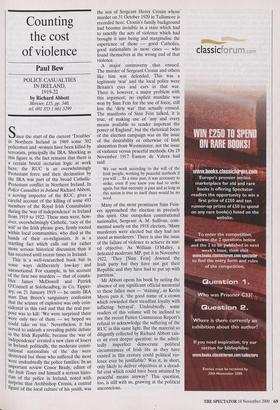Counting the cost of violence
Paul Bew
POLICE CASUALTIES IN IRELAND, 1919-22 by Richard Abbott Mercier, £15, pp. 340, tel: 001 353 1 661 5299 Since the start of the current 'Troubles' in Northern Ireland in 1969 some 302 policemen and -women have been killed by terrorists, principally the IRA. Shocking as this figure is, the fact remains that there is a certain brutal sectarian logic at work here; the RUC is an overwhelmingly Protestant force and their decimation by the IRA was part of the broad Catholic- Protestant conflict in Northern Ireland. In Police Casualties in Ireland Richard Abbott, a serving inspector of the RUC, gives a careful account of the killing of some 493 members of the Royal Irish Constabulary during the 'war of independence' in Ireland from 1919 to 1922. These men were, how- ever, overwhelmingly Catholic, 'racy of the soil' as the Irish phrase goes, firmly rooted within local communities, who died at the hands of their co-religionists. It is a startling fact which calls out for rather more serious historical discussion than it has received until recent times in Ireland.
This is a well-researched book but in some ways deliberately low-key and unemotional. For example, in his account of the first two murders — that of consta- bles James McDowell and Patrick O'Connell at Soloheadbeg, in Co. Tipper- ary, on 21 January 1919 — he omits IRA man Dan Breen's sanguinary confession that the seizure of explosive was only coin- cidental in this raid and that the real pur- pose was to kill: 'We were surprised there were only two of them — we hoped we could take on ten.' Nevertheless, it has served to unleash a revealing public debate in the Irish Republic, because the 'war of Independence' created a new class of losers in Ireland; politically, the moderate consti- tutional nationalists of the day were destroyed but those who suffered the most Were undoubtedly the police families. In an Important review Conor Brady, editor of the Irish Times and himself a serious histo- rian of the police in Ireland, noted with surprise that Archbishop Cronin, a central figure of the local culture of his youth, was the son of Sergeant Henry Cronin whose murder on 31 October 1920 in Tullamore is recorded here. Cronin's family background had become invisible in a state which had to sanctify the acts of violence which had brought it into being and marginalise the experience of those — good Catholics, good nationalists in most cases — who found themselves at the wrong end of that violence.
A major controversy thus ensued. The murder of Sergeant Cronin and others like him was defended. This was a legitimate 'war' and the local police were Britain's eyes and ears in that war. There is, however, a major problem with this argument; no explicit mandate was won by Sinn Fein for the use of force, still less the 'dirty war' that actually ensued.
The manifesto of Sinn Fein talked, it is true, of making use of 'any and every means available to render impotent the power of England', but the rhetorical focus of the election campaign was on the issue of the desirability or otherwise of Irish abstention from Westminster, not the issue of violence versus peaceful methods. On 19 November 1917 Eamon de Valera had said:
We can work according to the will of the Irish people, working by peaceful methods if you will ... In a time past, it was necessary to strike, even if you knew you had to strike again, but that necessity is past and as long as this nation is true to itself there would be no need.
Many of the most prominent Sinn Fein- ers approached the election in precisely this spirit. One outspoken constitutional nationalist, Sergeant A. M. Sullivan, com- mented sourly on the 1918 election, 'Many murderers were elected but they had not stood as murderers.' There is also the issue of the failure of violence to achieve its stat- ed objective. As William O'Malley, a defeated moderate MP, put it in November 1922, 'They [Sinn Fein] downed the Irish party but they have not got their Republic and they have had to put up with partition.'
Mr Abbott opens his book by noting the absence of any significant official memorial to these fallen men — 'staining', as Kevin Myers puts it, 'the good name of a crown which rewarded their steadfast loyalty with inflicting betrayal'. Undoubtedly, some readers of this volume will be inclined to see the recent Patten Commission Report's refusal to acknowledge the suffering of the RUC in this same light. But the material so diligently collected by Richard Abbott rais- es an even deeper question: in the admit- tedly imperfect democratic political circumstances of Irish life as they have existed in this century could political vio- lence ever be justifiable? Was it, in short, only likely to deliver objectives at a dread- ful cost which could have been attained by peaceful means anyway? This question, too, is still with us, gnawing at the political unconscious.


































































































 Previous page
Previous page